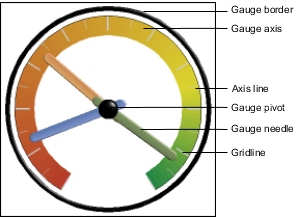When you create a gauge chart, you can choose
from a variety of chart templates, which offer different shape, axis,
and border options.
You can customize the following
aspects of your gauge chart. As you modify properties, the chart preview
shows you what your chart will look like.
Unless indicated in the user interface, all sizes
are a percentage of the maximum allowed.
If your gauge chart
includes a border, long axis labels, such as 250,000,000, may overlap
the gauge border and be difficult to read. To avoid this problem,
customize the data format of your gauge chart measure and reduce the
scale so that less zeros are displayed. Or change the gauge border
color or size or remove the border.
Procedure
- Click the gauge chart object.
- If you want to change the shape of the gauge, modify the
start and end angles of the gauge axes and border, as follows:
- In the Properties pane, under General,
double-click the Gauge Axes property and specify
the start and end angles and the direction of the axes.
- Double-click the Gauge Border property
and specify the style and the start and end angles of the border.
For example, a border start angle of 0 degrees and end angle
of 180 degrees produces a semi-circular gauge.
- If you want to add an additional axes to a gauge chart,
do the following:
- In the Properties pane, under General,
double-click the Gauge Axes property.
- Click the new button
 and specify the start and end angles
and the direction of the new axis.
and specify the start and end angles
and the direction of the new axis.
- If you want to change the size, shape, and color of the
center pivot point, double-click the Gauge Pivot property
and specify the style.
- If you want to change the indicators in the gauge axis,
click the Gauge Axis object in the chart and
do the following:
- To change the needle, under Axes,
double-click the Gauge Needle property and
specify the style.
- To change, add, or remove color bands that indicate
the data range positions, under Color & Background,
double-click the Gauge Axis Colors property
and specify the color palette.
- If you want to change the size or thickness of the gauge
axis and color bands, under Axes, specify a
percentage size for the Gauge Axis Inner Radius and Gauge
Axis Outer Radius properties.
- If you want to change the gridlines, under General,
double-click the Gridlines or Minor
Gridlines properties and specify the style.
- If you want to change the appearance of the gauge axis
line, under General, double-click Axis
Line.


 and specify the start and end angles
and the direction of the new axis.
and specify the start and end angles
and the direction of the new axis.